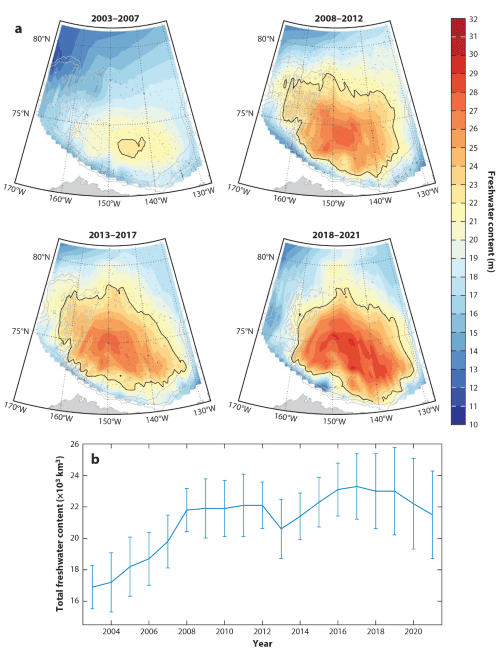Timmermans, M.-L., & Toole, J. M., 2023. The Arctic Ocean’s Beaufort Gyre. Annual Review of Marine Science, 15(1). https://doi.org/10.1146/annurev-marine-032122-012034

Figure provided by John Toole
An international, sustained measurement program sampling the Arctic Ocean north of Alaska (a study presently named the Beaufort Gyre Observing System – BGOS – https://www2.whoi.edu/site/beaufortgyre/) was initiated in 2003 to document this rapidly evolving region of the earth. A new paper to appear in Annual Reviews of Marine Science by Timmermans and Toole highlights various aspects of this ocean region. An important feature of Beaufort Gyre is the low salinity lens that has formed at the surface due to the anticyclonic (clockwise) wind stress on the ocean that drives convergent surface water flow and in turn, the anticyclonic Beaufort Gyre. Over the course of the BGOS program, an accumulation of liquid fresh water in the Gyre has been observed, see figure. Ship and buoy observations made in late summer each year were analyzed to estimate the changes in fresh water content in the ocean. Shown in panel (a) of the figure are maps at 5-year interval of the amount of fresh water per unit area that has been mixed into the ocean above the 34.8 isohaline (lying roughly at 400 m depth) to achieve the observed salinities (that are all less than 34.8). The time series of fresh water content integrated over the region given in Panel (a) shows that the fresh water content increased markedly between 2003 and 2008, reaching a maximum around 2017 before leveling off. (The error bars in Panel B give the rms error in the integrated fresh water content estimates.) This increase in fresh water content has been attributed to anomalously strong and sustained cyclonic wind forcing (Proshutinsky et al., 2019). If/when the winds and this lens of low salinity surface water relax, these low-density waters may spread south to influence air-sea interactions in the subpolar North Atlantic, as has been observed previously in connection with Great Salinity Anomaly events (Belkin et al. 1998). The Timmermans and Toole analysis also highlights the increase in upper ocean heat content that appears related to the poleward retreat of the sea ice cover in summer. The heat content increase appears related to the loss of sea ice – the classic ice-ocean albedo feedback mechanism. Clearly the Arctic is changing rapidly – the on-going BGOS program and related observational studies will document its future evolution.
